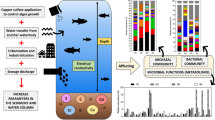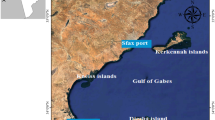Abstract
The Ribandar solar saltern, situated adjacent to the Mandovi estuary is influenced by the barge transport of ferromanganese ore to the Mormugao harbour (Arabian Sea). The current study focuses on the distribution of metals and related heterotrophic bacterial populations in the surface sediments (0–10 cm) of the Ribandar salterns (Goa, India) during the salt-making (January to May) and non salt-making seasons (August and November). The concentrations of heavy metals in the sediments ranged from 17.2 ± 2.8 to 26.3 ± 6.7 % Fe; 0.6 ± 0.2 to 0.9 ± 0.2 % Mn; 27.6 ± 7.3 to 51 ± 8.3 ppm Ni; 28.4 ± 8.9 to 35.2 ± 10.6 ppm Co; 44 ± 21.6 to 62.8 ± 23.6 ppm Zn; 0.1 ± 0.01 ppm Cd and 1.7 ± 0.1 to 2.6 ± 0.7 ppm Pb and were much higher than those reported at the same site in a previous study by Kerkar (2004). Hg concentrations were below detection limits. In general, computation of “geoaccumulation index” revealed the sediments as ‘uncontaminated to moderately contaminated’ with Fe, Mn, Ni, Co, Pb and Zn during the salt-making season. The abundance of metal-tolerant bacteria was comparatively restricted to the salt-making season and was higher than the non salt-making season. Fe-, Mn-, Ni-, Co- and Pb- (200 ppm) tolerant bacteria were retrieved and restricted to the surface sediments (0–5 cm), Cd and Fe being the two most regulatory elements governing bacterial populations in the non salt-making season. However, during the salt-making season, the concentration of Zn was found to be pivotal in regulating the counts of Fe-, Mn- and Ni-tolerant bacteria. In general, the strength of correlation of metals and microbes was higher in the non salt-making season as compared to the salt-making season. This would probably indicate metal-induced limitations in microbial populations in the non salt-making season and the absence of this effect during the salt-making season. In this study, we test the hypothesis that solar salterns behave as ecological sinks with a potential to transform native bacterial populations to metal-resistant strains, in relation to the dynamic changes in the surrounding metal concentrations.





Similar content being viewed by others
References
Abu-Hilal, A. H., & Badran, M. I. (1990). Effect of pollution sources on metal concentration in sediment cores from the Gulf of Aqaba (Red Sea). Marine Pollution Bulletin, 21, 190–197.
Alagarsamy, R. (2006). Distribution and seasonal variation of trace metals in surface sediments of the Mandovi estuary, west coast of India. Estuarine, Coastal and Shelf Science, 67, 333–339.
Attri, K., & Kerkar, S. (2011). Seasonal assessment of heavy metal pollution in tropical mangrove sediments (Goa, India). Journal of Ecobiotechnology, 3(8), 9–15.
Balaram, V., Ramesh, S. L., & Anjaiah, K. V. (1995). Comparative study of the sample decomposition procedures in determination of trace and rare elements in anorthosites and related rocks by ICP-MS. Fresenius’ Journal of Analytical Chemistry, 353, 176–182.
Biksham, G., Subramaniam, V., & van Griken, R. (1991). Heavy metal distribution in the Godavari river basin. Environmental Geology and Water Sciences, 17, 117–126.
Bruins, M. R., Kapil, S., & Oehme, F. W. (2000). Microbial resistance to metals in the environment. Ecotoxicology and Environmental Safety, 45, 198–207.
Bryan, G. W., & Langston, W. J. (1992). Bioavailability, accumulation and effects of heavy metals in sediments with special reference to United Kingdom estuaries: a review. Environmental Pollution, 76, 89–131.
Carver, R. E. (1971). Procedures in sedimentary petrology. New York: Wiley.
Day, P. R. (1965). Particle fractionation and particle-size analysis. In C. A. Black (Ed.), Methods of soil analysis, Part 1 (pp. 545–567). Madison: American Society of Agronomy.
de Sousa, S. N. (1999). Effect of mining rejects on the nutrient chemistry of Mandovi estuary, Goa. Indian Journal of Marine Sciences, 28, 355–359.
Dickinson, W. W., Dunbar, G. B., & McLeod, H. (1996). Heavy metal history from cores in Wellington Harbour, New Zealand. Environmental Geology, 27, 57–69.
EI-Sayed, M. K. (1980). Effect of sewage effluent on the sediments of Nordasvatnet (a land lock fjord), Norway. Marine Pollution Bulletin, 13, 85–88.
Fitchko, J., & Hutchinson, T. (1975). A comparative study of heavy metal concentration in river mouth sediments around the Great Lakes. Journal of Great Lakes Research, 1, 46–78.
Haristha, S., Kerkar, S., & Loka Bharathi, P. A. (2002). Mercury and lead tolerance in hypersaline sulphate-reducing bacteria. Marine Pollution Bulletin, 44, 726–732.
Howarth, R. W. (1979). Pyrite: its rapid formation in a salt marsh and its importance in ecosystem metabolism. Science, 203, 49–51.
Kerkar, S. (2004). Studies on bacteria of the dissimilatory reductive processes of the sulphur cycle from the salt pans of Goa. Ph.D Thesis. Goa: Department of Marine Sciences, Goa University.
Kerkar, S., & Loka Bharathi, P. A. (2007). Stimulation of sulfate-reducing activity at salt-saturation in the salterns of ribandar, Goa, India. Geomicrobiology Journal, 24, 101–110.
Kralik, M. (1999). A rapid procedure for environmental sampling and evaluation of polluted sediments. Applied Geochemistry, 14, 807–816.
Lasat, M. M. (2002). Phytoextraction of toxic metals: a review of biological mechanisms. Journal of Environmental Quality, 31, 109–120.
Li, Z., Xu, J., Tang, C., Wu, J., Muhammad, A., & Wang, H. (2006). Application of 16S rDNA-PCR amplification and DGGE fingerprinting for detection of shift in microbial community diversity in Cu-, Zn-, and Cd-contaminated paddy soils. Chemosphere, 62, 1374–1380.
Maheswari, N. (1994). Study of arsenic and related parameters along the central west coast of India. Ph.D Thesis. Goa: Department of Marine Sciences, Goa University.
Marschner, H. (1995). Mineral nutrition of higher plants. London: Academic.
Martincic, D., Kwokal, Z., & Branica, M. (1990). Distribution of Zn, Pb, Cd and Cu between different size fractions of sediments In the Limski Kanal (north Adriatic Sea). Science of the Total Environment, 95, 201–215.
McGrath, S. P., Zhao, F. J., & Lombi, E. (2001). Plant and rhizosphere processes involved in phytoremediation of metal contaminated soils. Plant and Soil, 232, 207–214.
Müller, G. (1969). Index of geoaccumulation in sediments of the Rhine River. Geological Journal, 2(3), 108–118.
Müller, G. (1979). Schwermetalle in den sedimenten des Rheins e Vera¨nderungen seit 1971. Umschau, 79, 778–783.
Müller, G. (1980). Schwermetalle in den sedimenten des Elbe bei Stade. Naturwissenschaften, 67, 560–561.
Murthy, C. S., Das, P. K., Nair, R. R., Veeraya, M., & Varadachari, V. V. R. (1976). Circulation and sedimentation processes in and around the Aguada Bay. Indian Journal of Marine Sciences, 5, 9–17.
Qasim, S. Z., & Sen Gupta, R. (1981). Environmental characteristics of the Mandovi–Zuari estuarine system in Goa. Estuarine, Coastal and Shelf Science, 13, 557–578.
Rubio, B., Nombela, M. A., & Vilas, F. (2000). Geochemistry of major and trace elements in sediments of the Ria de Vigo (NW Spain): an assessment of metal pollution. Marine Pollution Bulletin, 40, 968–980.
Silver, S., & Misra, T. K. (1984). Bacterial transformations of and resistances to heavy metals. Basic Life Sciences, 28, 23–46.
Singh, M., Ansari, A. A., Müller, G., & Singh, I. B. (1997). Heavy metals in freshly deposited sediments of the Gomati River (a tributary of the Ganga River): effects of human activities. Environmental Geology, 29, 246–252.
Souza, M. J. D., Nair, S., LokaBharathi, P. A., & Chandramohan, D. (2006). Metal and antibiotic-resistance in psychrotrophic bacteria from Antarctic marine waters. Ecotoxicology, 15, 379–384.
Stoffers, P., Glasby, G. P., Wilson, C. J., Davies, K. R., & Walter, P. (1986). Heavy metal pollution in Wellington Harbour. New Zealand Journal of Marine and Freshwater Research, 20, 495–512.
Stumm, W., & Morgan, J. J. (1996). Aquatic chemistry (3rd ed.). New York: Wiley.
Thomilson, D. C., Wilson, D. J., Harris, C. R., & Jeffrey, D. W. (1980). Problems in heavy metals in estuaries and the formation of pollution index. Helgolander Wissenschaftliche Meeresuntersuchungen, 33(1–4), 566–575.
Ukpong, I. E. (1997). Mangrove swamp at a saline fresh water interface near Creek Town, south-eastern Nigeria. Catena, 29, 61–71.
Upadhyay, S., & Sen Gupta, R. (1995). The behaviour of aluminium in waters of the Mandovi estuary, west coast of India. Marine Chemistry, 51, 261–276.
Varma, K. K., & Rao, L. V. G. (1975). Temporal and spatial variations in hydrographic conditions of Mandovi estuary. Indian Journal of Marine Sciences, 4, 11–17.
Wang, Y., Shi, J., Wang, H., Lin, Q., Chen, X., & Chen, Y. (2007). The influence of soil heavy metals pollution on soil microbial biomass, enzyme activity, and community composition near a copper smelter. Ecotoxicology and Environmental Safety, 67, 75–81.
Acknowledgements
We thank H.O.D. Department of Biotechnology, Goa University and Shri Rasik Ravindra, Director, National Centre for Antarctic and Ocean Research, Goa, for providing the lab facilities and also Dr. Thamban Meloth (Programme Director, Laboratories) for his constant support. We also wish to express our thanks to Mr. Rupesh Kumar Sinha for assistance in the field work. Comments from the anonymous reviewer have enhanced the quality of the manuscript considerably.
Author information
Authors and Affiliations
Corresponding author
Rights and permissions
About this article
Cite this article
Pereira, F., Kerkar, S. & Krishnan, K.P. Bacterial response to dynamic metal concentrations in the surface sediments of a solar saltern (Goa, India). Environ Monit Assess 185, 3625–3636 (2013). https://doi.org/10.1007/s10661-012-2814-7
Received:
Accepted:
Published:
Issue Date:
DOI: https://doi.org/10.1007/s10661-012-2814-7




